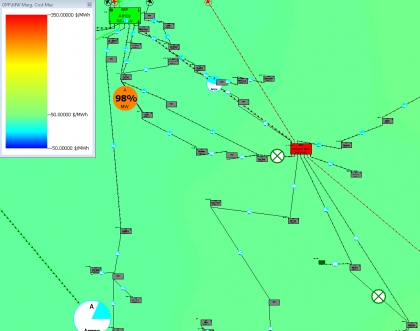Popular Science Recognizes ENG Professor for CleanTech Innovation
Power Grid Optimization Software Lowers Costs, Boosts Renewables
By Mark Dwortzan

In its June issue, Popular Science recognized Research Associate Professor Pablo Ruiz (ME) as one of 12 trailblazing energy technology innovators. Ruiz leads a team of researchers that has designed software that locates electric power grid congestion and reroutes power to less active transmission lines. Uncorking power grid bottlenecks this way could enable utilities not only to prevent blackouts but also to tap a higher percentage of electric power from renewable sources such as the sun and wind. The payoff: $1 billion to $2 billion annual savings in power generation costs.
To reap these benefits, no hardware upgrades are required; all a utility needs to do is install the software.

Supported by a $2.4 million grant from the Department of Energy’s Advanced Research Programs Agency (ARPA-E) and additional funding from the Massachusetts Clean Energy Center, the research team has spent the past two-and-a-half years advancing algorithms to help grid operators more actively manage power flows by optimally turning entire power lines on and off to reduce congestion, increase utilization of renewable resources, lower carbon dioxide emissions and make the power grid more resilient to disruptions from failure, natural disaster or attack.
The team consists of researchers from Boston University—including Professors Michael Caramanis (ME, SE) and Yannis Paschalidis (ECE, SE)—Tufts University and Northeastern University; The Brattle Group, an energy consulting firm where Ruiz serves as a senior associate; PJM Interconnection, which runs the largest power market in the US covering many eastern states; and software companies Newton Energy Group, AIMMS and Polaris Systems Optimization.

“Drawing on our combined expertise in power transmission systems operations, optimization, machine learning and electric power markets, we have advanced algorithms designed to make power grids more resilient and accommodating to clean energy sources,” said Ruiz.
When power transmission lines reach their capacity in a particular region during high demand periods, controllers have little choice but to tap local power plants to keep the electricity flowing and prevent blackouts. This practice, which favors expensive, local generation sources such as coal and natural gas over cheaper, typically more remote, renewable sources such as wind farms and solar arrays, adds an estimated $4 billion to $8 billion per year to the cost of running the US power grid. As more and more renewable generation sources join the grid and increase transmission line congestion, that price is expected to rise substantially.
The researchers have developed algorithms and software that can produce short-term changes in the power transmission network that redistribute power across the network and utilize renewable sources without overloading transmission lines. Based on a fundamental law of physics dictating that electric current is distributed along the paths of least resistance, the algorithms are designed to discover, in real time, preferred reconfigurations of the transmission network. Out of tens of thousands of transmission lines, the software selects a few, perhaps four or five, whose connection or disconnection will minimize the “spilling” or waste of inexpensive wind or solar generation that typically occurs during high-congestion periods.
“By removing a small number of critical transmission lines, you change the relative resistances across alternative network paths, and electric power redistributes itself, relieving the congestion,” said Caramanis, the project’s co-principal investigator. “If you disconnect the right lines, you can relieve congestion, increase use of inexpensive power sources and lower congestion costs.”
Two years ago, the researchers implemented initial algorithms to reproduce real-life situations in collaboration with the PJM transmission system. Since then, they have worked to make their software more practical for power grid engineers in the control room.
First, they developed a much higher-precision model of a power transmission system based on the PJM system, which disperses electric power to approximately 100,000 nodes in the transmission network. Second, they improved the algorithms so that when an operator reconfigures transmission lines, the change will provide lower congestion and power generation costs for at least four hours. Third, they considerably increased renewable energy transmissions in its simulations, reducing wasted wind and solar electric power by 50 percent.
Ruiz and his collaborators are now working to transition the technology to industry. If the software is adopted across PJM or other vast transmission networks, controllers seeking to relieve congestion will have the capability to connect and disconnect selected transmission lines every half hour or hour as needed, replacing a traditional, tedious and error-prone process with a 21st-century, automated, high-precision tool.
Ruiz presents the concept behind the team’s transmission network “Topology Control Algorithms” (TCA) in a video produced by ARPA-E.